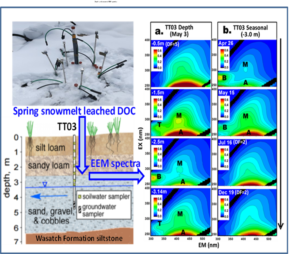Berkeley Lab geochemists and hydrologists who study a mountainous watershed near Rifle, CO, discovered that spring snowmelt is essential to the transport of freshly dissolved organic matter (DOM) from the top soil to the part of the Earth’s subsurface that lies above the groundwater table. Because dissolved organic matter undergoes biological humification over the year, these processes involving this deep vadose zone suggest an annual cycle of DOM degradation and transport at this semi-arid floodplain site.

Spring snowmelt transports fresh DOM from top soil into the deeper vadose zone, and then undergoes microbial humification process over the year (see depth and seasonal EEM spectra)
Summary
Scientists studying DOM in surface waters considered it to be the mobile fraction of natural organic matter that falls into or is washed into water bodies. Although it has been extensively studied over many decades, relatively little is known about the dynamics of DOM in the subsurface of semi-arid environments. In order to understand transport and humification processes of DOM within a semi-arid floodplain at Rifle, Colorado, the authors applied fluorescence excitation-emission matrix (EEM) spectroscopy, humification index (HIX) and specific UV absorbance (SUVA) for characterizing depth and seasonal variations of DOM composition. They found that late spring snowmelt leached relatively fresh DOM from plant residue and soil organic matter down into the deeper vadose zone (VZ). More humified DOM is preferentially adsorbed by upper VZ sediments, while non- or less-humified DOM was transported into the deeper VZ. Interestingly, DOM at all depths undergoes rapid biological humification processes as evidenced by the products of microbial by-product-like matter in late spring and early summer, particularly in the deeper VZ, resulting in more humified DOM at the end of year. The finding indicates that DOM transport is dominated by spring snowmelt, and DOM humification is controlled by microbial degradation. It is expected that these relatively simple spectroscopic measurements (e.g., EEM spectroscopy, HIX and SUVA) applied to depth- and temporally-distributed pore-water samples can provide useful insights into transport and humification of DOM in other subsurface environments as well.
Citation
Dong, W., J. Wan, T. K. Tokunaga, B. Gilbert, and K. H. Williams (2017). Transport and Humification of Dissolved Organic Matter within a Semi-Arid Floodplain. Journal of Environmental Sciences 57, 24-32, DOI: 10.1016/j.jes.2016.12.011
